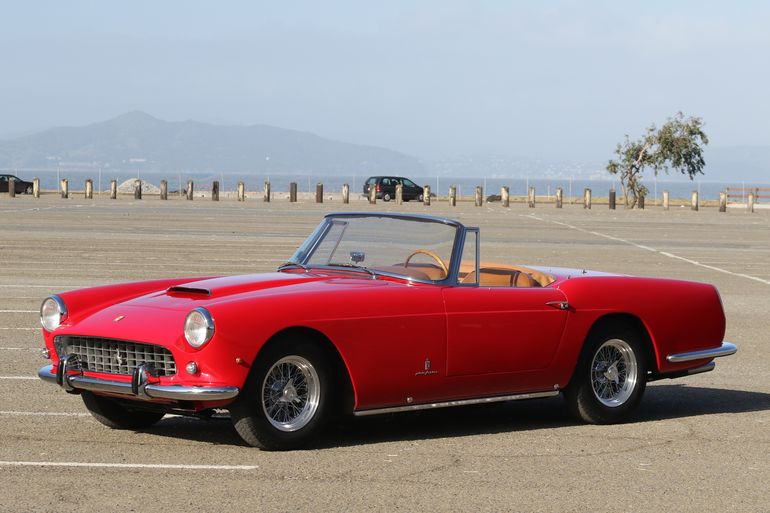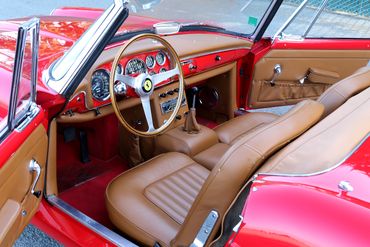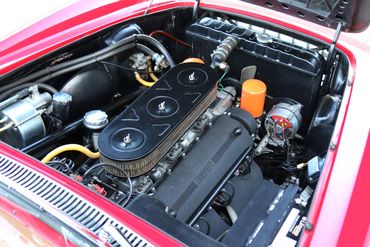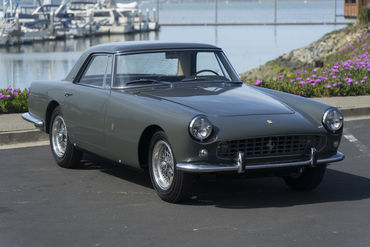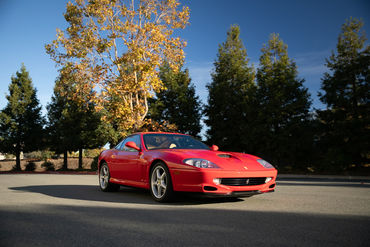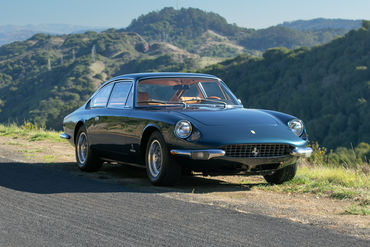Sold
SOLD 05/20
1962 Ferrari
250GT Pininfarina Cabriolet Series II
Classiche Redbook Certified Matching Numbers Example, Accompanied by Receipts for Work Done in Maranello, Massini Report, FIVA card.
- VIN3453GT
- Exterior ColorRosso Corsa
- Interior ColorSaddle Leather
- Mileage95906 Kilometers (TMU)
- Engine3.0L V12
- Engine no.3453
- Transmission4-Speed with Overdrive
- StatusSold
- StockFJ2401
Description
1962 Ferrari 250 GT Series II PininFarina Cabriolet
s/n 3453, Engine no. 3453 (internal no. 178/62E)
Pininfarina Body no. 299971
Rosso with Saddle Leather
Among the more exciting and road going GT cabriolets ever offered by Ferrari, the 250 series delivered remarkable style and performance at the dawn of a defining decade for performance automobiles. Ferrari entered the 1960’s fully engulfed in the growing demand for their capable road cars, both to showcase racing technology, and as a means to provide income for racing support. Each car was a personalized statement of excellence, and an invaluable financial emissary for racing success. And while every 250 was uniquely constructed, the Pininfarina coachbuilt Cabriolet was the most sought-after road car as it combined a spacious trunk, large interior capacity, and prodigious road manners. Fitted with the venerable 3-litre V-12, triple Weber 36 DCS two-barrel carburetors, four-speed synchromesh transmission with overdrive, independent front suspension, and four-wheel disc brakes, the 250 GT cabriolet culminated in 1962 with just 202 handmade Series II examples delivered to fortunate and pleased customers.
Every hand-built 250 GT Cabriolet offered exceptional quality, bespoke materials, and distinctive styling, specifically aimed at top Ferrari clientele. Those able to purchase these fine cars were offered Connolly leather, a full complement of performance instruments, and of course an array of stunning colors and interiors from which to choose. And while all contemporary Ferraris expensive propositions, the Pininfarina Cabriolet came at an even higher premium; in excess of $15,000 when new. With such pricing and rarity, it is understandable that exemplary style leaders, royalty, or historically prominent individuals would end up comprising the roster of fortunate owners.
This Ferrari 250 Cabriolet (#3453) has been documented by renowned Ferrari historian Marcel Massini, certified by Ferrari Classiche, significant restoration work performed in Maranello, and documented with photos in the Classiche Red Book, all of which thoughtfully detail and present the history and factory correct features of this matching number example. Crafted as #171 of 202 in this series, this 508 E/Cabriolet was delivered to Carrozzeria Pininfarina in Torino, Italy on Feburary 9, 1962. Completed May 9, 1962, the car was delivered to Renato Nocentini’s Garage La Rontonda, in Prato, nor far from Florence, Italy. Finished in Giallo Tijuana with Blue Connolly leather, it certainly must have made a striking statement in these original colors, particularly considering its future destination, favoring the national flag of Sweden. The car was sold that year to Mr. Van Lieberge, a Dutch citizen who had the car delivered to Scandinavia. In 1968 the car was sold to Staffen Gustaf Erick Kjellberg, a resident of Stockholm, Sweden who later sold it in 1972 to Peder Bonnier also a resident of Stockholm. During his ownership, the exterior was painted metallic silver. In 1986, the car was sold to Peter Lindkvist a resident of Lidingo, Sweden. Lindkvist restored the car, painted it red, and reupholstered the interior with black leather. The car was registered on Swedish plates “CCL 097”.
Lindkvist retained the car for quite some time including attendance at the AvD-Oldtimer Grand Prix at the Nurburgring, Germany in 1991. By 1995 Lindkvist had sold the car to a buyer in England when shortly thereafter, the car subsequently arrived in the Netherlands where it remained until 2000. By the early 2000s, the car is known to have been sold to Luis Lopez-Van Dam, a resident of Madrid, Spain where the car was registered on Spanish license plates “H 1268 BBC”. In February 2008 from the 8-17th, the car was featured on display at the 33rd Annual Retromobile, Paris, France, this time shown painted red with tan interior, including the dashboard covered in matching tan leather. At this time, the odometer showed 78,000 kms. In Spring 2010, after comprehensive refurbishment in excess of $75,000.00 performed at Maranello, the car is issued a Certificate of Authenticity by Ferrari Classiche and driven by Lopez-Van Dam and Paloma Romero at the Ferrari Tribute in the Mille Miglia at Brescia with race #506. In February 2013, the car is sold to Paul Michaels’ Hexagon Classics, London, England.
By March 2016, under current ownership, the current owner engages the services of GP Enterprises, Palo Alto, CA to perform a general inspection and tune up including new spark plugs, oil and filter, a new overdrive solenoid, new voltage regulator, removal of the oil pan for internal inspection, tightening of rear axle seal nuts, adjustment for the oil pressure, a compression check, brake fluid bleed and system flush, and other minor details totaling over $8,000.00.
Compression readings are noted at:
1-160 7-155
2-160 8-160
3-165 9-160
4-165 10-165
5-160 11- 160
6-160 12-150
In November 2016, the car returned to GP Enterprises for additional work including the installation of five new Pirelli 165VR 15 tires and tire tubes. Also, at this time, the carburetors were adjusted, the overdrive unit checked, and electrical adjustments made to improve overdrive engagement. Invoice total was $4,400.00.
As documented in the Ferrari Classiche Certificate, this matching numbers 250 Cabriolet displays three correct Weber 36 DCS carburetors, correct Magneti Marelli S85A ignition, the correct gearbox, type 508 E, no. 535 E and correct differential, numbered 508 E Cab. no. 73 CA. Also fitted and identified in the Red Book are the Borrani RW 3591 alloy wire wheels and factory correct Dunlop calipers and disc brakes. During the time the car was evaluated By Ferrari Classiche (2010) a FIVA Identity Card was issued and updated in London in 2013.
Today, this wonderfully presented 250 Cabriolet still retains the quality and refinement achieved in the restoration and subsequent professional services, showing signs of enjoyable use, but still remaining very attractive. The exterior finish is representative of very good quality driver-level cosmetics with glossy paint having been professionally detailed and tended to with expert care. The panel fit is consistent, with consistent door gaps offering a firm snap when closed. The hood, and trunk gaps are excellent, opening and closing smoothly without issue. The chrome plating, lenses, glass, and trim are all properly finished and detailed to a very high standard, showing only minor hazing and light marks, most of which are only visible upon close examination. Lettering, emblems, and other details are finely detailed finishing touches. The laced Borrani wire wheels are in excellent condition, with polished aluminum rims, accented by chrome plated knockoffs and correct date markings. The distinctive egg crate grille retains a correct, softly dulled finish against the polished grille surround. Correct headlight rings define the distinctive Ferrari fascia of this period. The stance, elegantly dipped belt line, and stately presence delivers a tailored and refined appearance, contrasted by the stunning and unmistakably vivid red Ferrari color.
The interior is finished with supple tan leather, correctly trimmed throughout with the top of the dash having been covered in matching tan leather. Although not period correct, the dash-topped tan leather offers a visually elegant alternative to the typically seen textured satin black finish. An elegant array of restored performance gauges presents in excellent condition. The dash is finished off by a warmly hued wood-rim Nardi steering wheel with polished aluminum spokes and yellow and black prancing horse emblem. Finishes throughout the interior are consistent with an older restoration that has been enjoyed but properly tended to. There is minor soiling to the red carpet, primarily in the footboxes and some minor marks to the driver’s seatback left side corner, but overall the interior is quite nice. The black canvas soft top is in good condition with excellent headliner and latching mechanisms that smoothly lock in place against the windshield header.
Under the hood, the matching numbers Weber carbureted V12 engine has been comprehensively restored and correctly detailed using proper finishes, accurate accessories, and original style hardware. While some time has passed since the restoration was freshly completed, ongoing care has been given to each engine component, resulting in mild patina from use as an authentic sportscar. The unified historic provenance supported by the Massini report and Classiche Certificate is evident in the casting numbers and correctly finished features including the textured black cam covers, textured black exhaust shrouds, correct yellow fuel lines, and proper ignition. The spacious trunk compartment has been nicely finished with red carpeting matching the interior, and correct panels that conceal the matching spare Borrani wire wheel and tire in the recessed trunk location. Further inspection of the undercarriage reveals a well prepared and tidy chassis with correct dual exhaust, correct aluminum engine and gearbox castings, and a correct aluminum chassis pan. The visual inspection of the undercarriage and major chassis tubes reveals no evidence of structural compromise and features correctly prepared finishes, supporting the history and confirming the mild use enjoyed since the restoration was completed.
The car starts immediately settling into a wonderful idle, revealing the gently muffled V12 sounds engineered for Ferrari road cars. Everything about the car is harmonious and comfortable, from the smooth shifter to the easily engaged clutch and operable overdrive when properly engaged. The drivability and ease of use is a relief from many freshly restored cars that are often only timidly enjoyed when driven. Power is strong when pushed, with progressive throttle response and solid communication from the balanced chassis. Cruising at leisurely speeds, it is easy to see how these cars were so favored by enthusiasts seeking a car they could drive spiritedly with plenty of trunk space to allow for extended vacations, long road trips, or in today’s modern vintage events. This delightful Ferrari Series II Cabriolet comes with the Ferrari Classiche Red Book, FVIA papers, a 250GT brochure, Jim Riff Service and Maintenance Manual, restoration records from Maranello, service records from selected past and recent work, keys, and the detailed history report produced by Marcel Massini.
The handsome Ferrari 250 GT Series II Cabriolet has always and will always remain an exceptional sportscar; combining superlative Italian craftsmanship and sophisticated engineering. As prices for long and short wheelbase California Spyders have advanced well beyond the means of many enthusiasts, each of the 202 250 GT Cabriolets produced have become increasingly recognized for their great value and usability. Rare in number and seldom available, these open sportscars continue to attract astute collectors in part because of their attractive Pininfarina coachwork and 250 Ferrari mechanicals, but also because they are so enjoyable on the road. Offering open motoring, exceptional performance, iconic Ferrari colors, and the thrill of Ferrari ownership, this Series II Cabriolet is sure to delight anyone who seeks a very enjoyable car ready to use in a wide range of vintage events and proudly display on the field of any major concours.
The above vehicle information is complete and accurate to the best of our knowledge at the time it is posted to this website. Corrections or additional information is always appreciated. All advertised prices exclude government fees and taxes, any finance charges, any dealer document preparation charge, and any emission testing charge. Vehicles are subject to prior sale. All advertised to be true but not guaranteed. We assume no liability for errors or omissions.
Inquire About This Car
Fantasy Junction • 510-653-7555 • 1145 Park Ave, Emeryville, CA 94608
